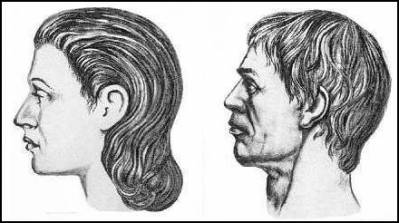
Ethnogenic Processes in East Europe and Asia till the Bronze Age
Prodrome
The population of Eastern Europe are still kept their traditional way of life of wandering hunter-gatherers, when a number of separate cultures was formed on the Balkan Peninsula and in the lower Danube in the 6th millennium BC. Common roots of these cultures were nourished by cultural flow penetrating to the South-East Europe across the Aegean area from Anatolia.
The first farmers and herdsmen penetrated on the territory from the Dniester River till the Lower Don from the south-west, and partly, perhaps, from the Caucasus (BROMLEY Yu.V., 1986, 292). Actually, these newcomers were the creators of the first Neolithic cultures in Eastern Europe. During their spread in the direction to the Carpathian Basin in the 5th mill BC, when farming and pastoral tribes were first settled here, occurred gradual transition from the Mesolithic to the Neolithic (HERRMANN JOACHIM , 1982, 43). The newcomers created the culture Linear Pottery in the area of the Carpathian arc which widened on large parts of Europe and even up to France. Several interrelated Neolithic cultures belonging to the circle of this culture are known in the Middle Danube. The earliest of these, the culture Körös, was created by people of the South-Balkan origin (SHUSHARIN V.P., 1971, 12).
Obviously, another group of newcomers had created the Bug-Dniester culture, which could have connection with the more advanced synchronous cultures of South-Eastern Europe. Mykola Tovkaylo said that after establishing contact with the culture of Körös in the "the outsets of productive economy i.e agriculture and livestock widened in the area of the Bug-Dniester culture" (TOVKAYLO M.T., 1998, 1). However we can also suppose that the elements of the new management had been made not only by simple contacts but with the resettlement of the population from the Balkan to the basin of the Southern Bug. Some large group of immigrants from the Balkans created here the Early-Trypillian culture. The race of the creators of the Trypillian culture can be identified by the anthropologic data which also confirm the wave of newcomers from the Balkans:
Obviously, another group of newcomers had created the Bug-Dniester culture, which could have connection with the more advanced synchronous cultures of South-Eastern Europe. Mykola Tovkaylo said that after establishing contact with the culture of Körös in the "the outsets of productive economy i.e agriculture and livestock widened in the area of the Bug-Dniester culture" (TOVKAYLO M.T., 1998, 1). However we can also suppose that the elements of the new management had been made not only by simple contacts but with the resettlement of the population from the Balkan to the basin of the Southern Bug. Some large group of immigrants from the Balkans created here the Early-Trypillian culture. The race of the creators of the Trypillian culture can be identified by the anthropologic data which also confirm the wave of newcomers from the Balkans:
The physical types of the people of the Tripollian culture is characterized by gracility and dolichocephaly.. Morphological features of this type are wide spread in Western Europe, Mediterranean, Asia Minor, besides special affinity with the Tripollians is shown by cranial series of Central Europe and the Mediterranean Basin (KONDUKTOROVA T.S. 1973, 49)

Left: Graphical Reconstruction of the Appearance of the Trypillians by M.M. Gerasimov on the basis of found sculls. (MASSON V.M., MERPERT N.Ya. 1982. Fig.)
The Bug-Dniester and Early-Typillian cultures coexisted in the same area and maintained close relationships a long time from the middle of the 1st to start of the 2nd quarter of the 4th BC (TOVKAYLO M.T. 1998, 14-15). At the same time (in the 5th mill BC) Neolithic cultures spread through the South and North Caucasus to the eastern part of the Ukraine (the Dnieper-Sura and the Dnieper-Donets cultures). The spreading was occurred by as resettlement and partly by borrowing the productive economy.
One can assume that third migration stream of the carriers of Neolithic cultures existed also from Asia along the eastern coast of the Caspian Sea to the right bank of the Ural River and thence to the Lower Volga. The archaic Yelshansk Neolithic culture in the area between these rivers may be evidence for such possibility:
One can assume that third migration stream of the carriers of Neolithic cultures existed also from Asia along the eastern coast of the Caspian Sea to the right bank of the Ural River and thence to the Lower Volga. The archaic Yelshansk Neolithic culture in the area between these rivers may be evidence for such possibility:
It is not excluded, that the territory of Central Asia was transformed into a semi-desert in connection with aridization. Living conditions deteriorated sharply, what resulted an outflow of population northward in a more favourable habitat. This area could be the Forest-steppe and the Volga region. Alien populations mingled with the natives and could borrow the local tradition of making stone tools (TURETSKIY M.A. 2007, 53).
Demographic expansion of farming communities from the Southern Caucasus and Anatolia to Eastern Europe could be due to a relative overpopulation in their primary habitat, or rather by achieving so-called "maximum of economic function", which determine the border for population growth in a certain area, occurred not only in natural way but also due to the retracting of small farming communities of neighbouring groups (ARUTIUNOV S.A. 1982: 72).











